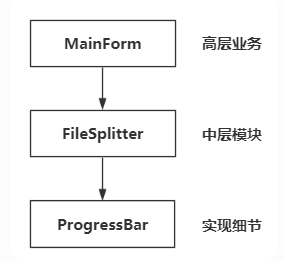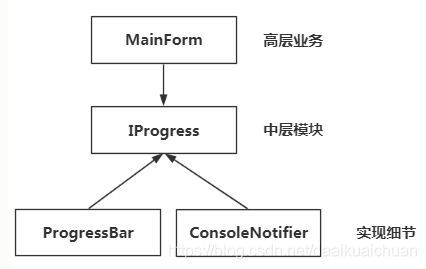一、概念
定义对象间的一种一对多(变化)的依赖关系,以便当一个对象(Subject)的状态发生改变时,所有依赖于它的对象都得到通知并自动更新。——《设计模式》GOF
二、动机
在软件构建过程中,我们需要为某些对象建立一种“通知依赖关系”,一个对象(目标对象)的状态发生改变,所有的依赖对象(观察者对象)都将得到通知。如果这样的依赖关系过于紧密,将使得软件不能很好的抵御变化。
使用面向对象技术,可以将这种依赖关系弱化,并形成一种稳定的依赖关系,从而实现软件体系结构的松耦合。
三、源代码讲解
class MainForm : public Form {
TextBox* txtFilePath; //文件路径
TextBox* txtFileNumber; //希望分割的个数
ProgressBar* progressBar; //(变化)添加进度条控件,用来显示进度
public:
void Button1_Click(){
//收集到用户输入的参数信息
string filePath = txtFilePath->getText();
int number = atoi(txtFileNumber->getText().c_str());
//(变化)传递给FileSplitter,让该类去分割文件
//将进度条传入文件分割类,在文件分割时改变进度条数据
FileSplitter splitter(filePath, number, progressBar);
//进行分割
splitter.split();
}
};
class FileSplitter
{
string m_filePath;
int m_fileNumber;
ProgressBar* m_progressBar;
public:
FileSplitter(const string& filePath, int fileNumber, ProgressBar* progressBar) :
m_filePath(filePath),
m_fileNumber(fileNumber),
m_progressBar(progressBar){ //(变化)初始化进度条参数
}
void split(){
//1.读取大文件
//2.分批次向小文件中写入
for (int i = 0; i < m_fileNumber; i++){
//(变化)...
float progressValue = m_fileNumber; //设计数据,更新进度条
progressValue = (i + 1) / progressValue;
m_progressBar->setValue(progressValue);
}
}
};
违背了第一个依赖倒置原则:高层模块不能依赖低层模块,二者都应该依赖抽象,抽象不能依赖实现细节,实现细节应该依赖抽象。
四、使用观察者模式进行改进
// 抽象基类,设计一个进度通知接口类
class IProgress {
public:
virtual void DoProgress(float value) = 0; // 0-1一个进度值
virtual ~IProgress() { }
};
// 中层模块
class FileSplitter {
string m_filePath;
int m_fileNumber;
List<IProgress*> m_iprogressList; // 抽象通知机制,支持多个观察者,实现具体到抽象的跃迁
// 上面实现了从紧耦合变为松耦合,FileSplitter没有再耦合一个具体细节(界面类)
public:
FileSplitter(const string& filePath, int fileNumber) :
m_filePath(filePath),
m_fileNumber(fileNumber) {
}
void split() {
// 1.读取大文件
// 2.分批次向小文件中写入
for (int i = 0; i < m_fileNumber; i++) {
// ...
float progressValue = m_fileNumber;
progressValue = (i + 1) / progressValue;
onProgress(progressValue); // 向所有观察者发送通知
}
}
void addIProgress(IProgress* iprogress) {
m_iprogressList.push_back(iprogress); // 添加观察者
}
void removeIProgress(IProgress* iprogress) {
m_iprogressList.remove(iprogress); // 移除观察者
}
protected:
virtual void onProgress(float value) {
List<IProgress*>::iterator itor = m_iprogressList.begin();
while (itor != m_iprogressList.end()) {
(*itor)->DoProgress(value); // 更新进度条
itor++;
}
}
};
// C++不推荐多继承,因为他会带来很多耦合性问题,但是支持一种,第一个是主继承,其他都是接口或者抽象基类
class MainForm : public Form, public IProgress {
TextBox* txtFilePath;
TextBox* txtFileNumber;
// 这里面使用progressBar是没有关系的,他和MainForm本身是一体的,紧耦合的
ProgressBar* progressBar;
public:
void Button1_Click() {
string filePath = txtFilePath->getText();
int number = atoi(txtFileNumber->getText().c_str());
ConsoleNotifier cn;
FileSplitter splitter(filePath, number);
splitter.addIProgress(this); //订阅通知
splitter.addIProgress(&cn); //订阅通知
splitter.split();
splitter.removeIProgress(this);
}
// 具体的通知机制
virtual void DoProgress(float value) {
// 主界面选择的GUI进度条,我们可以添加,也可以添加addIProgress(this)
progressBar->setValue(value);
}
};
class ConsoleNotifier : public IProgress {
public:
// 具体的通知机制
virtual void DoProgress(float value) {
cout << ".";
}
};

五、类图结构

六、要点总结
-
使用面向对象的抽象,Observer模式使得我们可以独立地改变目标与观察者,从而使二者之间的依赖关系达到松耦合。
-
目标发送通知时,无需指定观察者,通知(可以携带通知信息作为参数)会自动传播。
-
观察者自己决定是否需要订阅通知,目标对象对此一无所知。
-
Observer模式是基于事件的UI框架中非常常用(和Template一样常用)的设计模式,也是MVC模式中一个重要组成部分。
来源:CSDN
作者:lx青萍之末
链接:https://blog.csdn.net/daaikuaichuan/article/details/103654741